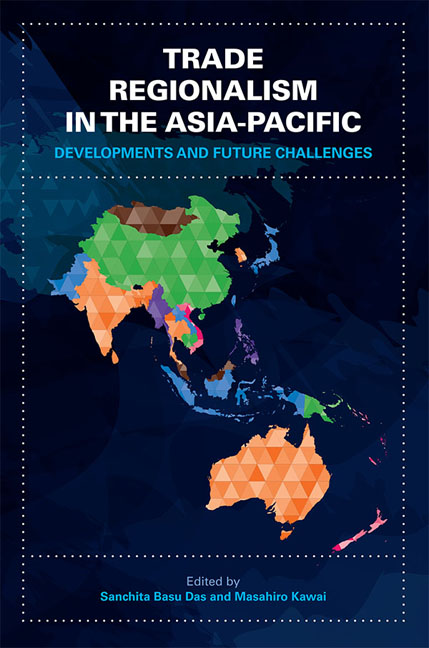Book contents
- Frontmatter
- Contents
- Foreword
- Acknowledgments
- List of Abbreviations
- The Contributors
- 1 Introductory Overview — Trade Regionalism in the Asia-Pacific: Developments and Future Challenges
- I The Trans-Pacific Partnership (TPP) Agreement
- II The Regional Comprehensive Economic Partnership (RCEP) Agreement
- III Regional Economic Integration: A Multi-stage Approach
- IV Old and Emerging Approaches to Asia-Pacific Regional Integration
- 12 APEC at 25: Political Realities Realized
- 13 The TTIP, Mega-regionalism and Asia
- 14 The Pacific Alliance: A Bridge between Latin America and the Asia-Pacific?
- V Asia-Pacific Regional Integration: Towards Convergence?
- Index
12 - APEC at 25: Political Realities Realized
from IV - Old and Emerging Approaches to Asia-Pacific Regional Integration
Published online by Cambridge University Press: 05 July 2016
- Frontmatter
- Contents
- Foreword
- Acknowledgments
- List of Abbreviations
- The Contributors
- 1 Introductory Overview — Trade Regionalism in the Asia-Pacific: Developments and Future Challenges
- I The Trans-Pacific Partnership (TPP) Agreement
- II The Regional Comprehensive Economic Partnership (RCEP) Agreement
- III Regional Economic Integration: A Multi-stage Approach
- IV Old and Emerging Approaches to Asia-Pacific Regional Integration
- 12 APEC at 25: Political Realities Realized
- 13 The TTIP, Mega-regionalism and Asia
- 14 The Pacific Alliance: A Bridge between Latin America and the Asia-Pacific?
- V Asia-Pacific Regional Integration: Towards Convergence?
- Index
Summary
INTRODUCTION
In 2013, Indonesia hosted the Asia-Pacific Economic Cooperation (APEC) Economic Leaders’ Meeting for the second time, on the grouping's twentyfifth anniversary and twenty years on from the Bogor APEC Economic Leaders’ Meeting. The differences in atmospherics between these two meetings were stark and telling.
In 1994, Indonesia hosted APEC's second leaders’ meeting that: (1) cemented this central institutional feature; and (2) announced its central and very ambitious institutional commitment — the “Bogor Goals” of free trade and investment by developed member economies by 2010 and by 2020 for developing ones. In this same year, U.S. economist C. Fred Bergsten (1994, p. 20), who later was appointed as the chairperson of APEC's Eminent Persons Group, proclaimed that: “Contrary to most expectations about regional economic organizations, the Asia-Pacific Economic Cooperation (APEC) forum is poised to become a driving force for worldwide trade liberalization.” At this time there was great hope that APEC would deepen regional economic integration among the Pacific Rim economies and through this buttress, the global trading system and the nascent World Trade Organization (WTO).
APEC's silver anniversary summit in Bali in 2013 lacked the sense of excitement and regional and international media interest of its Bogor predecessor and was much lighter on the deliverables side as well. While the Bali Declaration (with twelve pages of annexes) was ten times longer than the Bogor Declaration, it provided much less guidance for the future direction of APEC as a regional economic grouping, established no central new commitments, and recognized that the Bogor Goals were still that — goals.
The stark differences between Indonesia's two APEC years is reflective of APEC's path of restricting relevance, a path APEC has been propelled along by enduring international relations realities. Rather than countering sceptical expectations about what regional economic organizations can, and cannot, accomplish, APEC's experience has reinforced them as has the concurrent stalling of the WTO process. ASEAN's bold commitment to the establishment of an ASEAN Economic Community (AEC) by 2015 and the early days of the Regional Comprehensive Economic Partnership (RCEP) seem to be following along similar, reaffirming paths as well. India';s inclusion in RCEP adds significantly to its future potential just as Japan';s late inclusion in the Trans-Pacific Partnership (TPP) did.
- Type
- Chapter
- Information
- Trade Regionalism in the Asia-PacificDevelopments and Future Challenges, pp. 239 - 255Publisher: ISEAS–Yusof Ishak InstitutePrint publication year: 2016

